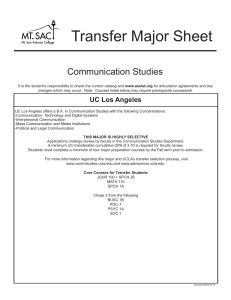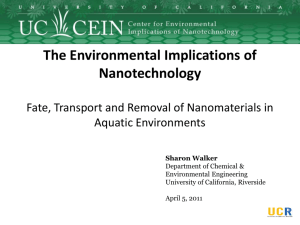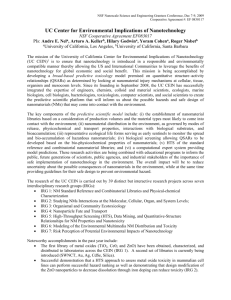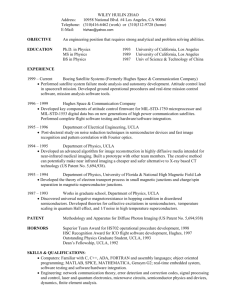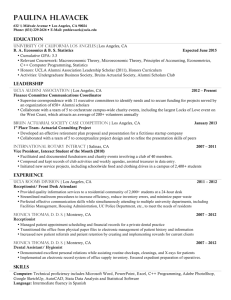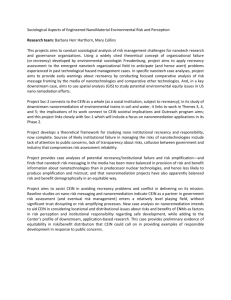UC Center for Environmental Implications of Nanotechnology 083017
advertisement
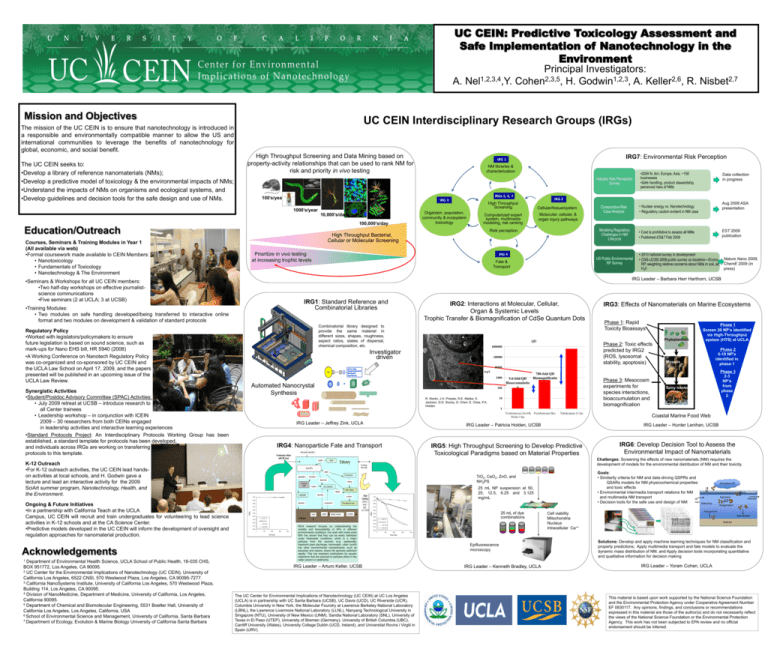
UC CEIN: Predictive Toxicology Assessment and Safe Implementation of Nanotechnology in the Environment Principal Investigators: A. Nel1,2,3,4,Y. Cohen2,3,5, H. Godwin1,2,3, A. Keller2,6, R. Nisbet2,7 Mission and Objectives UC CEIN Interdisciplinary Research Groups (IRGs) The mission of the UC CEIN is to ensure that nanotechnology is introduced in a responsible and environmentally compatible manner to allow the US and international communities to leverage the benefits of nanotechnology for global, economic, and social benefit. The UC CEIN seeks to: •Develop a library of reference nanomaterials (NMs); •Develop a predictive model of toxicology & the environmental impacts of NMs; •Understand the impacts of NMs on organisms and ecological systems, and •Develop guidelines and decision tools for the safe design and use of NMs. High Throughput Screening and Data Mining based on property-activity relationships that can be used to rank NM for risk and priority in vivo testing IRG 3 Education/Outreach Organism, population, community & ecosystem toxicology 10,000’s/day Computerized expert system, multimedia modeling, risk ranking Cellular/tissue/system Molecular, cellular, & organ injury pathways Prioritize in vivo testing at increasing trophic levels Data collection in progress IRG 4 Comparative Risk Case Analysis EST 2009 publication • Cost is prohibitive to assess all NMs • Published ES&T Feb 2009 US Public Environmental RP Survey Fate & Transport Aug 2008 ASA presentation • Nuclear energy vs. Nanotechnology • Regulatory caution evident in NM case Modeling Regulatory Challenges in NM Lifecycle High Throughput Bacterial, Cellular or Molecular Screening • 2010 national survey in development • CNS-UCSB 2008 public survey as baseline—Enviro Nature Nano 2009; RP, weighting relative concerns about NMs in soil, air, ChemE 2009 (in H2 0 press) IRG Leader – Barbara Herr Harthorn, UCSB •Seminars & Workshops for all UC CEIN members: •Two half-day workshops on effective journalistscience communications •Five seminars (2 at UCLA; 3 at UCSB) IRG1: Standard Reference and Combinatorial Libraries •Training Modules: • Two modules on safe handling developed/being transferred to interactive online format and two modules on development & validation of standard protocols IRG2: Interactions at Molecular, Cellular, Organ & Systemic Levels Trophic Transfer & Biomagnification of CdSe Quantum Dots Combinatorial library designed to provide the same material in different sizes, shapes, roughness, aspect ratios, states of dispersal, chemical composition, etc. Regulatory Policy •Worked with legislators/policymakers to ensure future legislation is based on sound science, such as mark-ups for Nano EHS bill, HR 5940 (2008) •A Working Conference on Nanotech Regulatory Policy was co-organized and co-sponsored by UC CEIN and the UCLA Law School on April 17, 2009, and the papers presented will be published in an upcoming issue of the UCLA Law Review. NPs X Y Z IRG3: Effects of Nanomaterials on Marine Ecosystems Phase 1: Rapid Toxicity Bioassays Phytoplankton Phase 2: Toxic effects predicted by IRG2 (ROS, lysosomal stability, apoptosis) Investigator driven Surface charge Hydrophilicity/phobicity Biomolecules Drug molecules 780-fold QD Biomagnificatio 5.6-fold QD n Bioaccumulatio n Automated Nanocrystal Synthesis Synergistic Activities •Student/Postdoc Advisory Committee (SPAC) Activities: • July 2009 retreat at UCSB – introduce research to all Center trainees • Leadership workshop – in conjunction with ICEIN 2009 – 30 researchers from both CEINs engaged in leadership activities and interactive learning experiences •Standard Protocols Project: An Interdisciplinary Protocols Working Group has been established, a standard template for protocols has been developed, and individuals across IRGs are working on transferring protocols to this template. R. Werlin, J.H. Priester, R.E. Mielke, S. Jackson, G.D. Stucky, G. Cherr, E. Orias, P.A. Holden Phase 3: Mesocosm experiments for species interactions, bioaccumulation and biomagnification Phase 1 Screen 20 NP’s identified via High-Throughput system (HTS) at UCLA Phase 2 5-10 NP’s identified in phase 1 Mussels Phase 3 2-3 NP’s from phase 2 Spiny lobster Coastal Marine Food Web IRG Leader – Jeffrey Zink, UCLA IRG Leader – Patricia Holden, UCSB IRG4: Nanoparticle Fate and Transport IRG Leader – Hunter Lenihan, UCSB IRG5: High Throughput Screening to Develop Predictive Toxicological Paradigms based on Material Properties IRG6: Develop Decision Tool to Assess the Environmental Impact of Nanomaterials Challenges: Screening the effects of new nanomaterials (NM) requires the development of models for the environmental distribution of NM and their toxicity. K-12 Outreach •For K-12 outreach activities, the UC CEIN lead handson activities at local schools, and H. Godwin gave a lecture and lead an interactive activity for the 2009 SciArt summer program, Nanotechnology, Health, and the Environment. Department of Environmental Health Science, UCLA School of Public Health, 16-035 CHS, BOX 951772, Los Angeles, CA 90095. 2 UC Center for the Environmental Implications of Nanotechnology (UC CEIN), University of California Los Angeles, 6522 CNSI, 570 Westwood Plaza, Los Angeles, CA 90095-7277. 3 California NanoSystems Institute, University of California Los Angeles, 570 Westwood Plaza, Building 114, Los Angeles, CA 90095. 4 Division of NanoMedicine, Department of Medicine, University of California, Los Angeles, California 90095. 5 Department of Chemical and Biomolecular Engineering, 5531 Boelter Hall, University of California Los Angeles, Los Angeles, California, USA 6 School of Environmental Science and Management, University of California, Santa Barbara 7 Department of Ecology, Evolution & Marine Biology University of California Santa Barbara High Throughput Screening •2009 N. Am, Europe, Asia, ~100 businesses •Safe handling, product stewardship, perceived risks of NMs IRG 2 Risk perception Courses, Seminars & Training Modules in Year 1 (All available via web) •Formal coursework made available to CEIN Members: • Nanotoxicology • Fundamentals of Toxicology • Nanotechnology & The Environment 1 IRGs 5, 6, 7 IRG #3 100’s/year 100,000’s/day Acknowledgements NM libraries & characterization Industry Risk Perception Survey 1000’s/year Goals: • Similarity criteria for NM and data-driving QSPRs and QSARs models for NM physicochemical properties and toxic effects • Environmental intermedia transport relations for NM and multimedia NM transport NP input • Decision tools for the safe use and design of NM TiO2, CeO2, ZnO, and NH2PS 1.00 1.00 0.90 0.90 0.80 0.80 0.70 0.70 0.60 0.60 C/C o C/C o Ongoing & Future Initiatives •In a partnership with California Teach at the UCLA Campus, UC CEIN will recruit and train undergraduates for volunteering to lead science activities in K-12 schools and at the CA Science Center. •Predictive models developed in the UC CEIN will inform the development of oversight and regulation approaches for nanomaterial production. IRG7: Environmental Risk Perception IRG 1 0.50 0.40 25 mL NP suspension at 50, 25, 12.5, 6.25 and 3.125 mg/mL 25 mL of dye combinations 0.50 0.40 ZnO 10 0.30 ZnO 50 0.20 ZnO 100 0.10 ZnO 200 0.00 0 100 ZnO 10 0.30 ZnO 50 0.20 200 Time (min) 300 400 IRG4 research focuses on understanding the mobility and bioavailability of NPs in different environmental conditions. Our work with metal oxide NPs has shown that they can be easily stabilized under freshwater conditions, which is a major pathway from the sources (e.g. wastewater treatment plant discharge, stormwater, other runoff) into other environmental compartments, such as estuaries and oceans, where the particles sediment rapidly. This has important implications for aquatic organisms that are exposed to particles either in the water column or sediments. ZnO 100 0.10 ZnO 200 0.00 0 100 200 300 Cell viability Mitochondria Nucleus Intracellular Ca++ Atmospheric NP Microlayer Aggregation Water Body Advection Disaggregation Resuspension Sedimentation Sediment 400 Time (min) IRG Leader – Arturo Keller, UCSB The UC Center for Environmental Implications of Nanotechnology (UC CEIN) at UC Los Angeles (UCLA) is in partnership with UC Santa Barbara (UCSB), UC Davis (UCD), UC Riverside (UCR), Columbia University in New York, the Molecular Foundry at Lawrence Berkeley National Laboratory (LBNL), the Lawrence Livermore National Laboratory (LLNL), Nanyang Technological University in Singapore (NTU), University of New Mexico (UNM), Sandia National Laboratory (SNL), University of Texas in El Paso (UTEP), University of Bremen (Germany), University of British Columbia (UBC), Cardiff University (Wales), University College Dublin (UCD, Ireland), and Universitat Rovira i Virgili in Spain (URV). Epifluorescence microscopy IRG Leader – Kenneth Bradley, UCLA Solutions: Develop and apply machine learning techniques for NM classification and property predictions; Apply multimedia transport and fate models to evaluate the dynamic mass distribution of NM, and Apply decision tools incorporating quantitative and qualitative information for decision making IRG Leader – Yoram Cohen, UCLA This material is based upon work supported by the National Science Foundation and the Environmental Protection Agency under Cooperative Agreement Number EF 0830117. Any opinions, findings, and conclusions or recommendations expressed in this material are those of the author(s) and do not necessarily reflect the views of the National Science Foundation or the Environmental Protection Agency. This work has not been subjected to EPA review and no official endorsement should be inferred.
